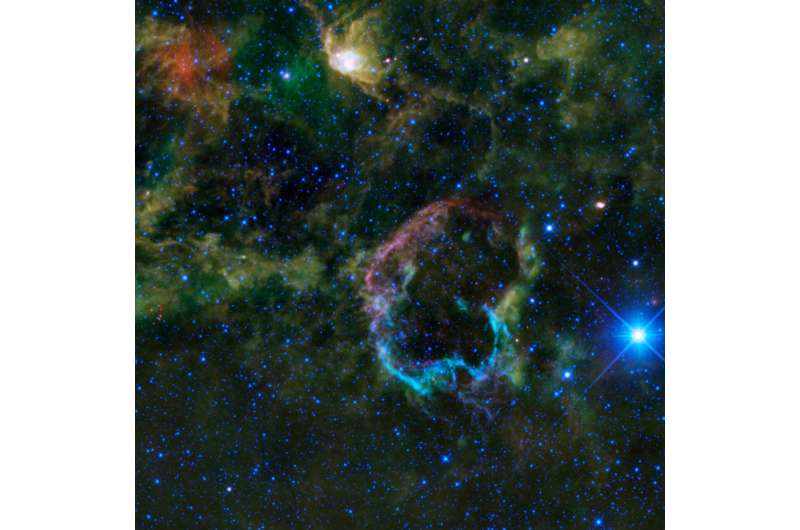August 24, 2021 report
Research sheds more light on the overionized recombining plasma in the supernova remnant IC 443

Astronomers have used ESA's XMM-Newton spacecraft to investigate the overionized recombining plasma in a supernova remnant (SNR) known as IC 443. Results of this research, published August 12 on arXiv.org, deliver essential information about the origin of this plasma in the studied SNR.
SNRs are diffuse, expanding structures resulting from a supernova explosion. They contain ejected material expanding from the explosion and other interstellar material that has been swept up by the passage of the shockwave from the exploded star.
Studies of supernova remnants are important for astronomers, as they play a key role in the evolution of galaxies, dispersing the heavy elements made in the supernova explosion and providing the energy needed for heating up the interstellar medium (ISM). SNRs are also believed to be responsible for the acceleration of galactic cosmic rays.
IC 443 is a galactic core-collapse SNR with a diameter of about 50 arcminutes and belongs to the GEM OB1 association at a distance of approximately 4,900 light years. The SNR exhibits a shell-like morphology in the radio band and centrally filled thermal X-ray emission.
Observations show that IC 443 appears to consist of two interconnected quasi-spherical subshells of different radii and centroids. It also turns out to have a quite complex environment as it interacts with a molecular cloud in the northwestern and southeastern areas and with an atomic cloud in the northeast.
IC 443 is perceived as one of the most important SNRs for studies of the so-called overionized recombining plasma (RP). Recent X-ray observations have unveiled the existence of plasmas in a recombination-dominant state in a dozen SNRs. Such plasmas have a higher ionization degree than that expected in collisional ionization equilibrium, therefore they were dubbed overionized recombining plasmas.
A team of astronomers led by Hiromichi Okon of the Harvard-Smithsonian Center for Astrophysics in Cambridge, Massachusetts, decided to observe the X-ray emission from IC 443 using XMM-Newton's European Photon Imaging Camera (EPIC). The main aim of these observations was to investigate overionized recombining plasma in this SNR, which could help astronomers better understand the physical origin of RPs in general.
The study found that RPs in regions interacting with dense molecular clouds in IC 443 tend to have lower electron temperature and lower recombination timescale. Based on the computation of the charge fraction for ions, this finding suggests that RPs in these locations are more cooled and more strongly overionized.
The astronomers noted that the observed properties of RPs in IC 443 could be explained by a rapid cooling via thermal conduction. They added that a similar result was reported for SNR W44, in which evaporation of clumpy gas embedded in the hot plasma causes the rapid cooling.
According to the paper, the other hypothesis that could possibly explain the overionization is that it was caused by ionization of protons. However, the astronomers disfavor this scenario as such proton bombardment is difficult to explain the observed properties of the RPs in IC 443.
More information: Hiromichi Okon et al, Investigation of the Physical Origin of Overionized Recombining Plasma in the Supernova Remnant IC 443 with XMM-Newton, arXiv:2108.05944 [astro-ph.HE] arxiv.org/abs/2108.05944
© 2021 Science X Network



















